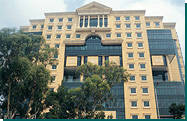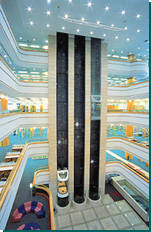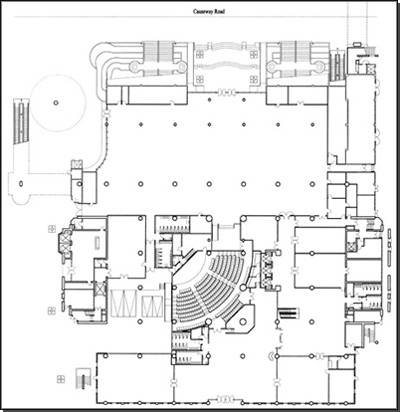| July
2001 |


|
|
|
Hong Kong Central Library
Central
resource
When
plans were decided on for a new central library beside Victoria
Park, the prominence of its location was recognised by its client,
the former Urban Council. Originally intended as a central library
for Hong Kong Island to complement existing facilities in Kowloon
and the New Territories, the project soon came to represent the
SAR as a whole. Building Journal spoke with Architectural Services
Department Senior Architect Ho Chiu-fan about Hong Kong's flagship
library.
To incorporate all the
client's requirements for a building housing not only a library
but also the Hong Kong Public Libraries Head Office and public facilities
including a lecture theatre and exhibition gallery, the architects
put their minds to an overall design concept. An east-meets-west
concept was adopted, referencing Western influence on Hong Kong
society and culture, with Chinese characteristics and thinking within.
As such, the building outlook features distinctly European elements
while the interior adopts a configuration reminiscent of the traditional
Chinese courtyard home.
Approach
The majority of visitors enter from the Victoria Park side,
either directly from the main road or via a newly-provided footbridge.
Two main staircases lead up a level from Causeway Road; each
representing Chinese and Western literature. With quotes engraved
on each step and aligned left, the staircases appear like open books
lying face up, with the centre handrails as the spines. Four recesses
branch from the lower flights of stairs to depict Hong Kong's night
sky during the four seasons with the glass panel star maps backlit
by fibre optics. Two additional recesses at the upper level feature
maps (the Western hemisphere on the west side and the Eastern hemisphere
on the east side) with planetary statistics included.
Rising up the stairs
past a central water feature, the visitor heads through an open
deck to the main entrance. Sculptures and installations feature
throughout the outdoor area, in particular bronze children, since
youth benefits from the cultivation a public library offers. Despite
the library's opening hours into the night, the podium deck features
few lampposts but instead uses floor lighting that lies visually
unobtrusive by day. The first-floor outdoor centrepiece is a granite
globe as part of a fountain; the stone ball's spin propelled by
water and the correct rotation axis ensured by a specially-designed
cylinder of lead within the globe. Water represents wisdom and the
humble in Chinese thinking, explained Ho, and in this case the liquid
shifts the hardest of materials. In additional symbolism, this spinning
Earth sits directly in front of the main entrance-the library faces
the world.
The podium deck offers an unobscured view of the 12-storey building's
facade, which adopts a classical approach. The main elevation features
a "gate of knowledge" as yellow glass reinforced concrete
(GRC) panels rise either side of curtain wall, coming together at
a central pediment at the top. The triangular pediment serves a
functional purpose, concealing antennae and the gondola system when
parked in a central position, but also represents a library's importance
to society. The Greek-style Ionic columns placed three to a side
represent liberty, democracy and wisdom (books overcome limits of
space and time in ensuring citizens)discourse and learning, explained
Ho.
The mixture of solid and glazed surfaces represents functions within
the library. The seventh floor in particular features GRC blocks
spanning much of the level, home to the library's Central Book Stack
area. Floor-to-ceiling glazing stretches on each floor appear where
reading and study areas are located, while shelving areas receive
more solid exterior treatments. "We wanted a beautiful harbour
view, " Ho said. "That's why we have a combination of
solids and voids to make the facade more interesting and to break
down the scale of the building." The off-site pre-cast GRC
panels, noted Ho, were chosen since the material can be hung onto
the structure, sparing the use of excessive formwork. The shade
of yellow chosen follows Chinese thinking-earth denotes the central
among the five elements of earth, water, metal, wood and fire, which
each hold representative colours.
Use of GRC also allowed moulding of architectural motifs, particularly
the Hong Kong Central Library symbol comprising a circle, a square
and a triangle-the sky, Earth and the accumulation of knowledge
respectively. Chinese characters for man and the sky are also held
in the design.
While the main elevation beckons visitors to a "Gate of knowledge"
the rear facade adopts a slightly different approach with a four-storey
"Window of hope" placed central. The glazed feature denotes
a goal of those entering the library and, while suggesting a conceptual
equilibrium between the two elevations, stands apart from symmetry
seen in classical Western design approaches.
Entry
Visitors entering the library pass either side of a glass screen
emblazoned with the Leisure and Cultural Services Department logo.
The traditional Chinese arrangement ensures the main door is never
leading a direct line into, or out of, the building. The main entrance
lobby offers a choice of directions: right to the circulation desks
or straight ahead to the main atrium's lifts and escalators. A cafeteria
is placed to the rear of the floor.
Banks of escalators carry library visitors up the Western end of
the six-storey main atrium while three elevators rise opposite,
set against a photographic backdrop of stars. Floors surrounding
the main atrium begin with the Children's Library on level two and
peak with the Audio Visual Library and Young Adult Library.
"We used the atrium to connect all the general library's floors
into one entity, so that when people come in they are not feeling
like they are coming into a building segregated for different functions
but one whole library with all functions interconnected by a central
atrium," Ho said. The central atrium is also used to infuse
natural light, with double-floor glazed areas provided at the fifth
and sixth floors. Light green-tinted laminated glass is specified
throughout the project to protect against UV and block out traffic
noise. The glass is non-reflective to avoid the glazing becoming
a mirror at night and blocking views outside. Motorised venetian
blinds are provided for the double-floor glazing.
All floors adopt a palette of materials that minimises reflective
elements. The majority of walls and columns within the shelving
and reading areas are finished with unpolished limestone and beechwood.
Blue carpet tile flooring is bordered with colours specific to the
floors-reinforcing the arrangement of individual functions on single
levels. Reading and learning materials are backed with computer
systems and self-checking lending services on each floor, all connected
through network floor systems underfoot.
The public library's main atrium ends beneath the seventh floor,
which is the Central Book Stack. The floor is used to store all
books not kept on the shelves. The library floors are connected
to a computerised book conveyor system that whisks materials to
wherever they are requested in the library.

The eighth and ninth
floors house a second, smaller central atrium for the two-storey
Reference Library. Set apart from the general library centered on
the main atrium below, the Reference Library is placed separately
in consideration of its use as a distinct area for academic study.
The Arts Library is housed on the tenth floor along with sound-proofed
music practice rooms. At the top of the building, on the eleventh
floor, is the Hong Kong Public Libraries Head Office, oriented to
face the harbour and featuring a rooftop courtyard garden to admit
natural light into the office areas.
Other than the library and head office functions, the project scope
also incorporated ground floor facilities including a lecture theatre,
a user education hall, extension activities rooms and an exhibition
gallery. Accessible separately at ground level, the facilities can
be used to conduct events without disturbing Central Library management.
Hong Kong Central Library opened in May this year. The building
cost was $594 million, including the footbridge to Victoria Park
and the sports ground behind the building.
Leisure
and Cultural Services Department
owner/developer
Architectural Services Department
architect
China State Construction Engineering Corporation
main contractor
|


